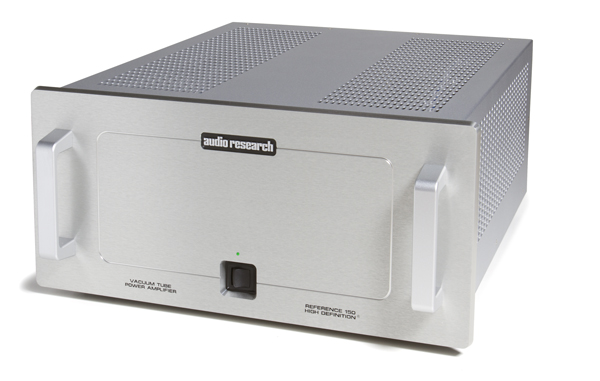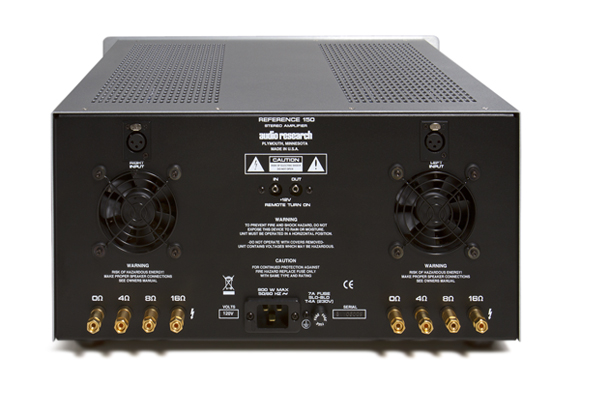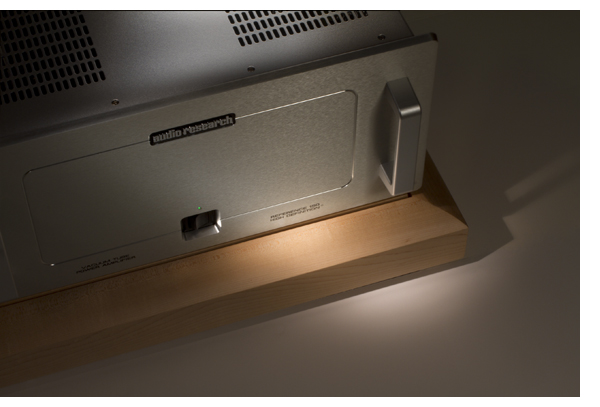Audio Research REF 150 Power Amplifier Single Box Perfection
By Jeff Dorgay Audiophiles have a habit of prematurely discarding things. In the 70s, a proliferation of low-efficiency box speakers and transistors convinced many enthusiasts to abandon vacuum tubes for high-powered solid-state amplifiers. Listeners were on a quest for “perfect measurements,” only to wonder if they’d made the wrong choice after the fact.
Audiophiles have a habit of prematurely discarding things. In the 70s, a proliferation of low-efficiency box speakers and transistors convinced many enthusiasts to abandon vacuum tubes for high-powered solid-state amplifiers. Listeners were on a quest for “perfect measurements,” only to wonder if they’d made the wrong choice after the fact.
History repeated itself again in the 80s with the compact disc, as many of the same devotees ditched vinyl in favor of “perfect sound forever” and the digital medium’s superior measurements. Fortunately, technology always seems to come full circle and often reaches its development pinnacle years after introduction. The ARC REF 150 power amplifier exemplifies this trend.
Tradition
The $12,995 REF 150 builds on the success of the previous $10,995 REF 110, the consummate one-box solution for audiophiles that don’t require the power of the larger REF 250 and 750 monoblocks. ARC executive Dave Gordon notes: “The REF 110 is a great amplifier. Yet the extra output of the REF 150 is perfect for our customers wanting the REF sound, but don’t want to commit to the space a pair of monoblocks required.” One chassis also has an advantage in that the REF 150 only requires replacing eight power tubes (approximately every 5000 hours) and, subsequently, produces less heat. Tubes are cooled by a pair of back-panel fans that only make themselves faintly known when the music is off. And even then, one must listen intently to hear them.
Looking virtually identical to its predecessor, the REF 150 sports major internal changes. There’s a much bigger power supply, with double the storage capacity of the REF 110, and redesigned output transformers to maximize the capacity of the KT120 output tubes. Past ARC power amplifiers use the 6550. However, the increased dissipation of the new KT120 tube allows for a substantial power increase. Proprietary capacitor technology utilized in the 40th Anniversary Reference Preamplifier significantly contributes to the new amplifier’s improved transparency. Currently, there’s no upgrade option for REF 110 owners. Still, Gordon mentions that the KT120 tube can be a drop-in replacement for the 6550 in the REF 110 and “provides a bump in power output, close to 20 watts per channel.” Not a bad upgrade for about $600.
Having owned numerous ARC power amplifiers during the past 30 years, I love that the company prefers a path of measured evolution rather than ricochet from one design to the next. This approach keeps high both demand and resale value for vintage ARC gear. Some older models are now worth more used than they were when new. The current hybrid design, featuring low noise JFETs in the first input stage, began back in the late 80s with the Classic 120 and Classic 150 monoblocks. The latter models ran eight 6550 tubes in each channel in triode mode. By comparison, the REF150 utilizes ARC’s patented “cross cathode coupled” output stage, delivering more power from half as many tubes—and providing better overall sound.
Listeners that find the last generation REF 110 amplifier slightly forward in tonal balance and requiring more juice to push will likely feel that the improvements made to the REF 150 a welcome change. ARC diehards, take note: The change in overall sound is almost identical to the improvement between the REF 3 preamplifier and REF 5. Audio Research achieves a delicate balance of delivering extra, almost-indefinable tonal tube richness while avoiding the common trap of masking resolution with warmth—or speed with an overblown soundstage. In other words, the REF 110 goes to 9.3 and the REF 150 goes to 11.
The REF 150 features a single pair of balanced XLR connections for the input and three output taps (4, 8, and 16 ohm) for speaker outputs. Thankfully, ARC employs quality copper binding posts instead of the awful, plastic-coated connectors used on too many of today’s power amplifiers. Solid connections are important, and these do the job. A 20-amp IEC socket is used for power transfer, as is a heavy-duty power cord.
Integrating the REF 150 into both of my reference systems—one featuring ARC’s REF Phono 2 phonostage and REF 5 preamplifier, the other comprised of the Burmester 011 preamplifier and Vitus Audio MP-P201 phonostage—proves seamless. Note: the design of the REF series power amplifiers is such that they will not work with single ended (RCA outputs only) preamplifiers. A balanced preamplifier must be used, or distortion will rise dramatically, accompanied by a substantial decrease in power. This is due to the omission of the phase inverter stage – a small price to pay for signal purity. Excellent synergy is also achieved running it direct from the dCS Paganini stack, in effect making the ARC an all-digital control center. No matter your front end, the REF 150 will deliver.
The REF 150 is equally versatile with a wide range of loudspeakers. While it can’t push my power-hungry Magnepan 1.7s to ear-busting levels, it plays them at coherent levels with all but heavy-rock tracks—a major feat for most amplifiers, and an incredible achievement for a tube amplifier. The new MartinLogan Montis speakers make for a fabulous combination with the REF 150, a match previously problematic due to the speakers’ low impedance (.56 ohms at 20kHz), The Montis’ slightly higher impedance combines with the REF 150’s superior drive to play extreme music at any level desired, with no loss of high-frequency information. It all reminds me of the synergy achieved years ago with ARC’s legendary D-79 power amplifier and MartinLogan’s CLS speakers.
Outstanding Impressions
I’m instantly struck by two characteristics: The REF 150 sounds more lifelike right out of the box than recent ARC components, and it possesses colossal bass grip. Those of the opinion that vacuum tube amplifiers can’t produce prodigious amounts of bass weight or control are in for a major paradigm shift. In these respects, the REF 150 amazes.
The Chemical Brothers “Galvanize,” from Push The Button, reveals wet and loose beats that challenge amplifiers to capture their gravitas. The REF 150 aces the test. Sampling everything from Pink Floyd to Stanley Clark shows the amplifier claims immense power and control over lower registers. Regardless of the speakers, the REF 150 goes deep, and yet, stops on a dime with bass transients. No, I don’t believe “tube watts” sound more powerful than “transistor watts.” But there’s no substitute for a well-designed power supply with ample reserve capacity. The REF 150 sounds much bigger and more dynamic than its power rating suggests.
Texture is treated in equal measure, leading me to an old audiophile favorite, The Three, a JVC direct-to-disc LP featuring Shelly Manne on drums, Joe Sample on piano, and Ray Brown on bass. Listening to Brown’s playing on “Satin Doll” is sublime, with every up-and-down movement of his fingers smartly distinguishable.
But man cannot live by bass alone, and the REF 150 excels with practically every other aspect of music reproduction. The amplifier’s ability to hold its poise when pushed very, very hard leaves me stunned. Warner Bros.’ analog remaster of Van Halen’s Van Halen II is no audiophile masterpiece, and the third track, “Somebody Get Me a Doctor,” often collapses into a one-dimensional experience. Yet, even at close-to-concert decibel levels, Eddie Van Halen and Michael Anthony’s background vocals retain distinct separation rather than just sounding like a single vocal.
Imagined or not, electric guitars reproduced through tube amplification represent the proverbial equivalent of an extra push over the cliff. The REF 150’s resolution is particularly tasty when listening to bands featuring multiple lead guitar players; think Judas Priest, Slayer, or Metallica. The title cut to Judas Priest’s Ram it Down personifies the increased power such tracks exert when you can easily discern multiple guitarists in the mix.
For those preferring to twirl rather than bang their head, look no further than Mobile Fidelity’s recent remaster of the Grateful Dead’s Live Dead. Filled with layer upon layer of guitar and keyboard tracks, the LP takes on new life via the ARC, revealing previously obscured tidbits. Consider: Jerry Garcia’s guitar begins as a whisper on “Saint Stephen,” yet when he ramps up the volume, the organ way off in the background doesn’t lose its integrity.
The REF 150 never stumbles, handling the power of a guitar solo or delicacy of a flute passage with ease. Without question, this amplifier roars when required. But thanks to its wide dynamic range and bandwidth, it retains a full-bodied sound at low playback levels. Those subscribing to the “first watt” theory (i.e., if the first watt isn’t great, the rest won’t be either) can rest assured the REF 150 is up to the task.
Rounding out my evaluation with wide range of vocal standards confirms initial impressions. The REF 150 is a very natural-sounding amplifier—never forward, bright, or harsh. Bob Dylan’s Bootleg Series Volume 8 comes off with the depth of a stereo record.
At first listen with any component, dynamics usually woo you into further listening sessions. However, tonal accuracy and overall natural sound are the sonic sauces that keep you on the couch for hours, seeking out “just one more record.” Sure, many Internet pundits complain that recorded music sounds nothing like the real thing. Pish. If your speakers and source components are up to task, the REF 150 will produce such sensations with the best recordings—and amply seduce you the rest of the time. Cream’s “Sleepy Time, Time” from its 1995 performance at Royal Albert Hall splendidly reproduces the venue’s ambience. I feel as if I’m sitting in the center of the 15th row in this famous concert hall—no surround speakers needed!
If you’re seeking classic tube-amplifier sound that is larger than life and full of romance, the REF 150 isn’t your bag. However, if you desire a modern amplifier possessing musical integrity, timbral accuracy, and wideband frequency response—yet still boasting the three-dimensionality, air, and tonal saturation hallmarks of mighty vacuum tubes—the REF 150 offers emotional engagement few amplifiers at any price can match.
Audio Research REF 150 Power Amplifier
MSRP: $12,995
Peripherals
| Preamplifier | ARC REF 5 Burmester 011 |
| Phono Preampflifier | ARC REF Phono 2 Vitus Audio MP-P201 |
| Analog Source | AVID Acutus Reference SP/SME V/Sumiko Palo Santos |
| Digital Source | dCS Paganini Sooloos Control 15 |
| Cable | Cardas Clear |
| Power | Running Springs Dmitri Maxim power conditioners |
| Accessorie | Furutech DeMag, Loricraft PRC-4 SRA Scuttle Rack |





